Cessation of daily wheel running differentially alters fat oxidation capacity in liver, muscle, and adipose tissue
- PMID: 18974364
- PMCID: PMC2636938
- DOI: 10.1152/japplphysiol.91186.2008
Cessation of daily wheel running differentially alters fat oxidation capacity in liver, muscle, and adipose tissue
Abstract
Physical inactivity is associated with the increased risk of developing chronic metabolic diseases. To understand early alterations caused by physical inactivity, we utilize an animal model in which rats are transitioned from daily voluntary wheel running to a sedentary condition. In the hours and days following this transition, adipose tissue mass rapidly increases, due in part to increased lipogenesis. However, whether a concurrent decrease in fatty acid oxidative capacity (FAO) in skeletal muscle, liver, and adipose tissue occurs during this period is unknown. Following 6 wk of access to voluntary running wheels (average distance of approximately 6 km a night), rats were rapidly transitioned to a sedentary state by locking the wheels for 5 h (WL5) or 173 h (WL173). Complete ([(14)C]palmitate oxidation to (14)CO(2)) and incomplete ([(14)C]palmitate oxidation to (14)C-labeled acid soluble metabolites) was determined in isolated mitochondrial and whole homogenate preparations from skeletal muscle and liver and in isolated adipocytes. Strikingly, the elevated complete FAO in the red gastrocnemius at WL5 fell to that of rats that never ran (SED) by WL173. In contrast, hepatic FAO was elevated at WL173 above both WL5 and SED groups, while in isolated adipocytes, FAO remained higher in both running groups (WL5 and WL173) compared with the SED group. The alterations in muscle and liver fat oxidation were associated with changes in carnitine palmitoyl transferase-1 activity and inhibition, but not significant changes in other mitochondrial enzyme activities. In addition, peroxisome proliferator-activated receptor coactivator-1alpha mRNA levels that were higher in both skeletal muscle and liver at WL5 fell to SED levels at WL173. This study is the first to demonstrate that the transition from high to low daily physical activity causes rapid, tissue-specific changes in FAO.
Figures
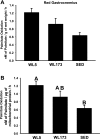
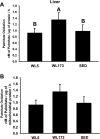
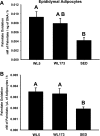
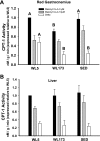
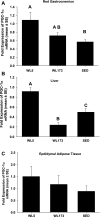
References
-
- Astrup A Healthy lifestyles in Europe: prevention of obesity and type II diabetes by diet and physical activity. Public Health Nutr 4: 499–515, 2001. - PubMed
-
- Baar K, Wende AR, Jones TE, Marison M, Nolte LA, Chen M, Kelly DP, Holloszy JO. Adaptations of skeletal muscle to exercise: rapid increase in the transcriptional coactivator PGC-1. FASEB J 16: 1879–1886, 2002. - PubMed
-
- Bandyopadhyay GK, Yu JG, Ofrecio J, Olefsky JM. Increased malonyl-CoA levels in muscle from obese and type 2 diabetic subjects lead to decreased fatty acid oxidation and increased lipogenesis; thiazolidinedione treatment reverses these defects. Diabetes 55: 2277–2285, 2006. - PubMed
-
- Bass A, Brdiczka D, Eyer P, Hofer S, Pette D. Metabolic differentiation of distinct muscle types at the level of enzymatic organization. Eur J Biochem 10: 198–206, 1969. - PubMed
-
- Blaak EE, van Aggel-Leijssen DP, Wagenmakers AJ, Saris WH, van Baak MA. Impaired oxidation of plasma-derived fatty acids in type 2 diabetic subjects during moderate-intensity exercise. Diabetes 49: 2102–2107, 2000. - PubMed
Publication types
MeSH terms
Substances
Grants and funding
LinkOut - more resources
Full Text Sources
Miscellaneous

